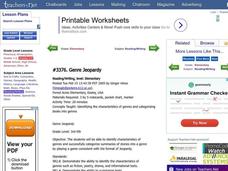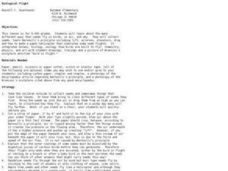Curated OER
Alphabetical Order
Pupils write spelling words for the week, or review words, in boxes that are large enough for students to cut out and manipulate with ease. After cutting them out pupils arrange them on their desk in alphabetical order.
Curated OER
Genre Jeopardy
Students participate in a game-like format to identify characteristics of genres. They categorize stories into genres bases on story summaries after a class discussion of the characteristics.
Curated OER
The Peaceable Kingdom
Students examine the life and works of Edward Hicks. Using his "Peaceable Kingdoms, they create what they believe to be their own peaceable kingdom. They compare and contrast the two kingdoms and practice layering colors with colored...
Curated OER
Pick It Up!
Students investigate recycling by creating receptacles that can hold trash or recyclable items. In this graphic design lesson, students encourage their classmates to help save the environment by using a recycling receptacle they...
Curated OER
"Q" Letter Ideas
Students participate in activities that begin with the letter q. They also expand their vocabulary.
Curated OER
T Letter Ideas
Students participate in activities that begin with the letter "T". They also expand their vocabulary.
Curated OER
Biological Flight
Students examine the many different ways that seeds fly in birds, in air, and why. In this science lesson plan, students collect seeds, learn Bernoulli's principle including lift, ailerons, elevators, drag and how to make a paper...
Curated OER
Music - Dancing To the Beat
Second graders discover the rhythm in music. Students walk around in a circle, swinging a ribbon to the beat of music. While keeping a steady beat, 2nd graders respond to suggested alterations to their rhythm.
Curated OER
Fables and Their Meanings
In this literature genre instructional activity, students read five short fables and select the correct moral of the fable from the drop down menu. This instructional activity is interactive.
Curated OER
Memory Game with a Smile
Students take it in turns to say two letters and then they turn the corresponding cards around to see if the pictures/words on them match. If they do, student who has found the pair wins 1 point.
Curated OER
Comma in a Series
Students practice adding commas to a list or series. They are given a sentence and asked to fix the sentence by adding commas in the correct position.
Curated OER
Conferences With Parents Who Don't Get Along
How to deal with parents of a student who don't get along with each other.
Curated OER
Bounce to Spell
Students are in their own personal space with a playground ball and a partner. They are given a spelling word from their classroom or shoolwide list. They bounce the ball to their partner saying a letter as they pass the ball.
Curated OER
Classroom Management Systems: Part 1
Keeping track of "transitions" is one of my classroom management systems.
Curated OER
Response to Intervention Can Help Students Struggling in Math
How to help your students who are struggling in mathematics before they fall too far behind.
Curated OER
The "Be Kind Kids" Project
Learners create a visual display that highlights friendship and kindness. They read and discuss a poem, and design and create a large poster or banner that emphasizes kindness, anti-bullying, and friendship.
Curated OER
Calder's Balancing Acts
Students learn the vocabulary of contemporary sculpture and distinguish between abstract and realistic sculpture, mobile and stabile, biomorphic and geometric. They write equations using Calder's mobiles


















